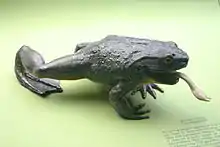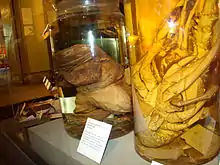Goliath frog
The goliath frog otherwise known as goliath bullfrog or giant slippery frog (Conraua goliath) is the largest living frog.[2] Specimens can grow up to 32 centimetres (13 in) in length from snout to vent, and weigh up to 3.25 kilograms (7.2 lb). This species has a relatively small habitat range in Cameroon and Equatorial Guinea.[3] Its numbers are dwindling due to habitat destruction and its collection for food and the pet trade.[1]
| Goliath frog | |
|---|---|
 | |
| Model at the American Museum of Natural History | |
| Scientific classification | |
| Kingdom: | Animalia |
| Phylum: | Chordata |
| Class: | Amphibia |
| Order: | Anura |
| Family: | Conrauidae |
| Genus: | Conraua |
| Species: | C. goliath |
| Binomial name | |
| Conraua goliath (Boulenger, 1906) | |
 | |
Description
The sexes of the goliath frog are similar.[4] In a sample of 15 individuals, weights ranged between 600 and 3,250 g (1.3 and 7.2 lb), and snout-vent lengths were between 17 and 32 cm (7 and 13 in).[3] Their eyes can be nearly 2.5 cm (1.0 in) in diameter. The conspicuous tympanum has a diameter around 0.5 cm (0.20 in) and is separated from the eye by about 5 cm (2.0 in) in adults. Goliath frog eggs and tadpoles are about the same size as other frogs despite their very large adult form.
A lateral fold extends from the eye to the posterior portion of the tympanum. Toes are fully webbed, with large interdigital membranes extending down to the toe tips. The second toe is the longest. The skin on the dorsum and on top of the limbs is granular. Dorsal coloration is green sienna, while the abdomen and ventral part of the limbs are yellow/orange. They have acute hearing, but no vocal sac, and also lack nuptial pads.
Distribution and habitat
The goliath frog is normally found in and near fast-flowing rivers with sandy bottoms in the Middle African countries of Cameroon and Equatorial Guinea.[3] These rivers are usually clear and highly oxygenated. Their actual range spans from the last 200 km (120 mi) of the Sanaga basin in Cameroon to the north to the last 50 km (31 mi) of the Benito River basin in Equatorial Guinea to the south. The river systems in which these frogs live are often found in dense, extremely humid areas with relatively high temperatures.
Although generally staying in the rivers during the day, they often emerge on land during the night.[4]
Ecology and behavior
Reproduction
Like most amphibians, water is vital for their reproduction. Because the goliath frog lacks a vocal sac, it does not produce mating calls, a behavior generally present in frogs and toads.[3] The egg masses consist of several hundred to a few thousand eggs, approximately 3.5 mm (0.14 in) each, and often attached to aquatic vegetation.[5][6] There are three main nest types, all semi-circular in shape and located in or near a river: In the first they clear a section in a river pool. In the second they expand an already existing pool, daming it off from the river. In the final they dig a pool, roughly 1 m (3 ft) wide and 10 cm (4 in) deep, sometimes moving quite large stones in the process. This may partially explain the goliath frog's large size, as larger frogs may be more successful at moving heavy objects when constructing their nests. Adults have also been shown to guard the nests at night. Although not confirmed, there are indications that the nest is constructed by the male, while the female guards the nest with the eggs.[6] Larval development takes between 85 and 95 days.
Diet
Goliath tadpoles are herbivorous and feed on a single aquatic plant, Dicraeia warmingii (Podostemaceae), found only near waterfalls and rapids, which may help explain their restricted range.[2] Adult goliath frogs feed on spiders, worms, and insects, such as dragonflies and locusts. They also eat fish, other amphibians (including newts, salamanders, and smaller frogs), mollusks, crabs, other crustaceans, baby turtles, young snakes, and small mammals. A bat reportedly was found in a goliath frog's stomach.[7][8]
Longevity
The goliath frog can live up to 15 years in the wild. In captivity, they can live up to 21 years. It is preyed upon by snakes, Nile crocodiles, Nile monitors, and humans, among other predators.
Conservation

The primary threat to the goliath frog is hunting, as it is considered a food source in its native range.[1] The IUCN has highlighted the need for conservation measures, in cooperation with local communities, to make sure the hunting is at sustainable levels.[1] To a lesser extent they are also threatened by habitat loss and degradation.[1] They were extensively exported to zoos and the pet trade, but have proven shy and nervous in captivity.[9] Although captives may live longer than their wild counterparts, the species has not been bred in captivity.[9][10] Due to their classification as an endangered species, the Equatorial Guinean government has declared that no more than 300 goliaths may be exported per year for the pet trade, but few now seem to be exported from this country.[2]
See also
- Helmeted water toad (Calyptocephalella gayi) – A South American species that can reach a similar length, but with a lower maximum weight
_Ranomafana.jpg.webp) Frogs portal
Frogs portal
References
- Amiet, J.-L. (2004). "Conraua goliath". IUCN Red List of Threatened Species. 2004: e.T5263A11121365. doi:10.2305/IUCN.UK.2004.RLTS.T5263A11121365.en.
- "Goliath Frog". The American Museum of Natural History. 2007. Retrieved 9 February 2012.
- Sabater-Pi, J. (1985). "Contribution to the biology of the Giant Frog (Conraua goliath, Boulenger)". Amphibia-Reptilia. 6 (1): 143–153. doi:10.1163/156853885x00047.
- Halliday, T. (2016). The Book of Frogs: A Life-Size Guide to Six Hundred Species from around the World. University of Chicago Press. p. 527. ISBN 978-0226184654.
- "True Frogs: Ranidae – Goaliath Frog(conraua Goliath): Species Accounts". Net Industries. 2008. Retrieved 9 February 2012.
- Schäfer, Marvin; Tsekané, Sedrick Junior; Tchassem, F. Arnaud M.; Drakulić, Sanja; Kameni, Marina; Gonwouo, Nono L.; Rödel, Mark-Oliver (2019). "Goliath frogs build nests for spawning – the reason for their gigantism?". Journal of Natural History. 53 (21–22): 1263–1276. doi:10.1080/00222933.2019.1642528. S2CID 202012353.
- "Conraua goliath". Animal Diversity Web.
- Mikula, P. (2015). "Fish and amphibians as bat predators". European Journal of Ecology. 1 (1): 71–80. doi:10.1515/eje-2015-0010.
- Indiviglio, Frank (31 January 2013). "The World's Largest Frog – Working with the Massive Goliath Frog". thatpetplace. Retrieved 4 November 2017.
- "Goliath Frog is a Disappearing Giant". Frogsource. Retrieved 4 November 2017.
External links
![]() Data related to Conraua goliath at Wikispecies
Data related to Conraua goliath at Wikispecies
Media
- Photos of goliath frogs with people at Queensland Frog Society
- Conraua goliath in the CalPhotos Photo Database, University of California, Berkeley
![]() Media related to Conraua goliath at Wikimedia Commons
Media related to Conraua goliath at Wikimedia Commons
